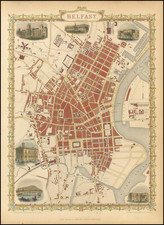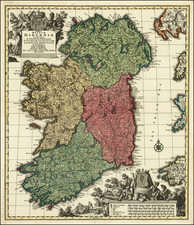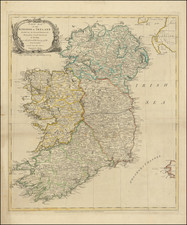Rare early sea chart of Ireland, from a six-part work by Matthaus Merian on the history of the Hanseatic League entitled Rebus Publicis Hanseaticis Tractatus . . . published in Frankfurt in 1641.
The map derives from Blaeu's important sea chart of Ireland published in his Zeespiegel, one of the greatest navigational guides of the 17th century. The map shows a beautiful rendition of all of the coasts of Ireland, and is remarkable for its accuracy on the west coast. Major ports and coastal features are named, although not always necessarily spelled correctly ("Dubling" for Dublin, "Korck" for Cork, "Dery" for Derry).
The map is orientated with north at the right, and shows parts of the English, Welsh, and Scottish coasts along the base of the map. Shoals are marked. A large title cartouche includes the Irish harp, and a compass rose appears in the lower left of the map.
Merian's 1641 edition of the De rebus publicis Hanseaticis. Tractatus generalis greatly enlarged the work with maps and charts of various parts of the world. The work was originally published by Johann Angeli Werdenhagen, the German ambassador to the Hanseatic League, and focused primarily on northern Europe and important trading regions.
Rarity
We trace only one example of this map appearing at auction in the past decade (misdescribed in the title as being a Bellin map, although the description correctly ascribed it to Merian.) We trace only two complete examples of the six-part book appearing at auction in the past thirty-five years.
Mathaus Merian (1593-1650) was the father of engraver Matthäus the Younger, and of the painter, engraver, and naturalist Maria Sibylla Merian. He was born in Basel, Switzerland and trained in engraving in Zurich. After a time in Nancy, Paris and Strasbourg, he settled in Frankfurt. While there, he worked for Johann Theodor de Bry, the publisher and son of the travel writer. In 1617, he married Maria Magdalena de Bry, Johann Theodor’s daughter. In 1623, Merian took over the de Bry publishing house upon the death of his father-in-law. Merian’s best known works are detailed town views which, due to their accuracy and artistry, form a valuable record of European urban life in the first half of the sixteenth century









![[Northwest Ireland] De West-Cust van Yerlandt tusschen C. Tellin en Slijnehooft](https://storage.googleapis.com/raremaps/img/small/75344.jpg)

![[Ireland / Sea Chart] Carte des Cotes Occidentales D'Irlande Reduite de la Carte de Stuart Amos Arnold et rectifee d'apres les Plans leves par M. MacKenzie Publiee Par ordres du Contr-amiral Decres Ministre de Marine et des Colonies . . . 1803](https://storage.googleapis.com/raremaps/img/small/63682.jpg)


